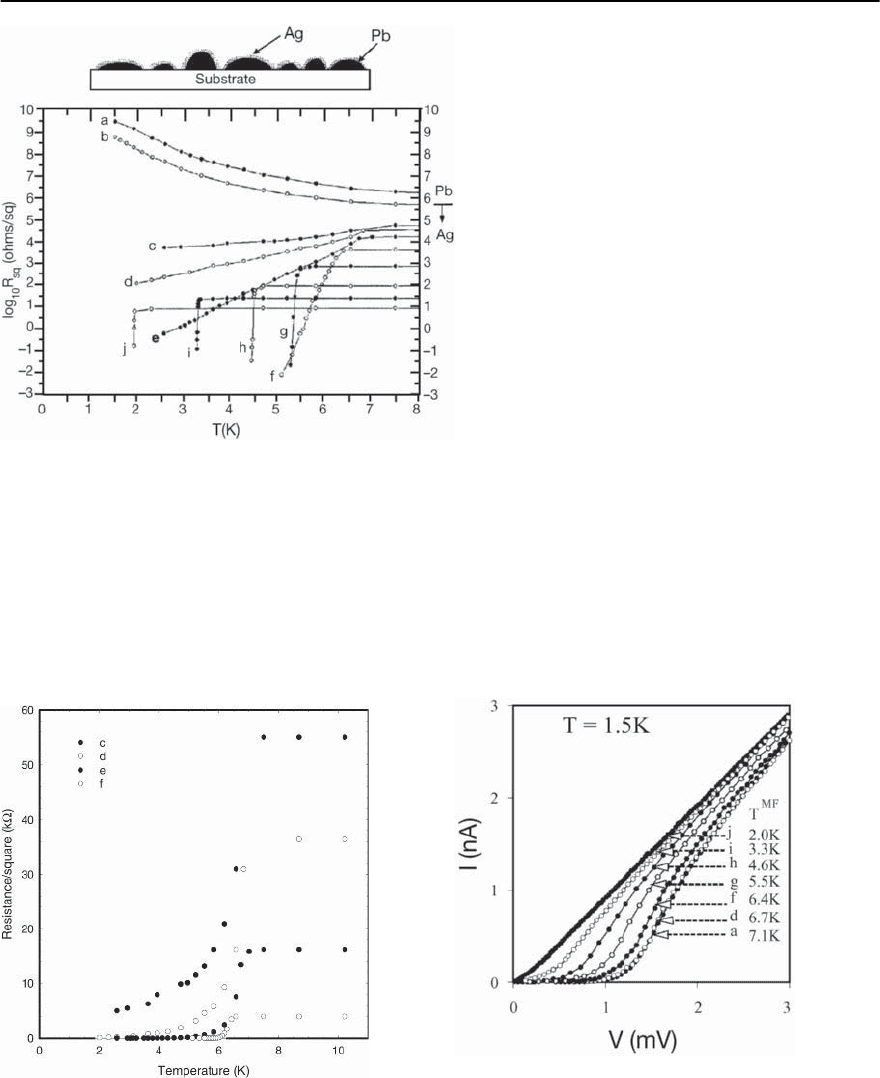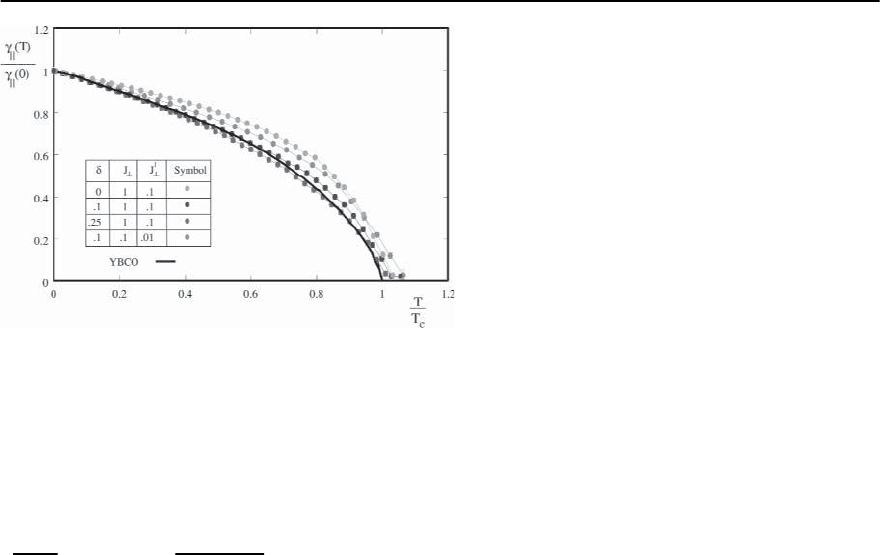Bennemann K.H., Ketterson J.B. Superconductivity: Volume 1: Conventional and Unconventional Superconductors; Volume 2: Novel Superconductors
Подождите немного. Документ загружается.


21 Concepts in High Temperature Superconductivity 1261
21.7.2 Is an Insulating Spin L iquid Ground State
Possible in D > 1?
Is this simply angels dancing on the head of a pin?
The most basic theoretical issue concerning the ap-
plicability of the fractionalization idea is whether a
spin liquid state occurs at all in D > 1. The typical
consequence of the Mott physics is an antiferromag-
netically ordered (“spin crystalline”) state, especially
the N´eel state, which indeed occurs at x =0inthe
cuprates. Moreover, the most straightforward quan-
tum disordering of an antiferromagnet will lead to
a spin Peierls state, rather than a spin liquid, as was
elegantly demonstrated by Haldane [220] and Read
and Sachdev [71]. Indeed, despite many heroic ef-
forts, the theoretical “proof of principle,” i.e. a theo-
retically tractable microscopic model with plausible
short range interactions which exhibits a spin liquid
ground state phase, was difficult to achieve.A liquid
is an intermediate phase, between solid and gas, and
so cannot readily be understood in a strong or weak
coupling limit [80].
Very recently, Moessner and Sondhi [79] have
managed to demonstrate just this point of principle!
They have considered a model [70] on a triangular
lattice (thus returning very closely to the original
proposal of Anderson) which is a bit of a caricature
in the sense that the constituents are not single elec-
trons, but rather valence bonds (hard core dimers),
much in the spirit pioneered by Pauling.
15
The model
is sufficiently well motivated microscopically,and the
spin liquidcharacter robust enough,that it is reason-
ableto declarethespin liquid a theoretical possibility.
The spin liquid state of Moessner and Sondhi does
not break any obvious symmetry.
16
Spin liquids are fragile.
That said, the difficulty in finding such a spin liquid
ground state in model calculations is still a telling
point.A time reversal invariant insulating state can-
not beadiabatically connectedto a problemofnonin-
teracting quasiparticles with an effectiveband struc-
ture
17
—band insulators always have an even number
of electrons per unit cell.Thus,an insulating spin liq-
uid is actually quite an exotic state ofmatter.Presum-
ably, it only occurs when all more obvious types of
ordered states are frustrated, i.e. those which break
spinrotational symmetry,translational symmetry,or
both. The best indications at present are that this oc-
curs in an exceedingly small corner of model space,
and that consequently spin liquids are likely to be
rather delicate phenomena, if they occur at all in
nature. This, in our opinion, is the basic theoreti-
cal reason for discarding this appealing idea in the
cuprates,where high temperature superconductivity
is an amazingly robust phenomenon.
The cuprates appear to be doped spin crystals, not
doped spin liquids.
One could still imagine that the insulating state is
magnetically ordered, as indeed it is in the cuprates,
but that upon doping, once the magnetic order is
suppressed, the system looks more like a doped spin
liquid than a doped antiferromagnet. In this con-
text, there are a number of phenomenological points
about thecupratesthat strongly discourage this view-
point. In the first place, the undoped system is not
only an ordered antiferromagnet, it is a nearly clas-
sical one: its ground state and elementary excita-
tion spectrum [221–224] are quantitatively under-
stood using lowest order spin wave theory.
18
This
state is as far from a spin liquid as can be imag-
ined! Moreover, even in the doped system, spin glass
and other types of magnetic order are seen to per-
sist up to (and even into) the superconducting state,
often with frozen moments with magnitude compa-
rable to the ordered moments in the undoped sys-
tem[224,227–229].These andother indications show
that the doped system“remembers”that it is a doped
antiferromagnet, rather a doped spin liquid.
15
Indeed, it is tempting to interpret the dimer model as the strong coupling, high density limit of a fluid of Cooper
pairs [70].
16
This work was,to some extent,anticipated in studies of large N generalizations of the Heisenberg antiferromagnet [71].
17
In a time reversal symmetry broken state, the band structure need not exhibit the Kramer’s degeneracy, so that a weak
coupling state with an odd number of electrons per unit cell is possible.
18
Recent experiments on La
2−x
Ba
x
CuO
4
at x =1/8 [225] are in agreement with spin wave calculations [226] throughout
the entire measured energy range.

1262 E.W. Carlson et al.
Where to look for spin liquids
Regardless of applicability to the cuprates, it would
be worthwhile to search for materials that do exhibit
spin liquidstates,and even more so to lookfor super-
conductivity when they are doped. Numerical stud-
ies [230–233] indicate that good candidates for this
are electrons on a triangular lattice with substantial
longer range ring exchange interactions,such as may
occur in a 2D Wigner crystal near to its quantum
melting point [234],and the Kagom´elattice.Itisalso
possible, as discussed in Sect. 21.11, to look for su-
perconductivity in systems that exhibit some form of
spin-charge separation at intermediate length scales
(see also [14]).
21.7.3 Topological Order and Electron
Fractionalization
Finally,we address the problem of classifying phases
in which true electron fractionalization occurs, e.g.
in which spinons are deconfined.It is now clear from
the workof Wen [78] and Senthil and Fisher [59] that
the best macroscopic characterization of fractional-
ized phasesin two or moredimensions is topological,
since they frequently possess no local order param-
eter. Specifically, a fractionalized phase exhibits cer-
tain predictable ground state degeneracies on vari-
ous closed surfaces—degeneracies which Senthil and
Fisher have given a physical interpretation in terms
of “vision expulsion.” Unlike the degeneracies asso-
ciated with conventional broken symmetries, these
degeneracies are not lifted by small external fields
which break either translational or spin rotational
symmetry. It has even been shown [59,218,235] (as
funny as this may sound) that topological order is
amenable to experimental detection. Once topolog-
ical classification is accepted, the one to one rela-
tion between spin liquids and electron fractional-
ization, implied in our previous discussion, is elim-
inated. Indeed, it is possible to imagine [59,76] or-
dered (broken symmetry) states, proximate to a spin
liquid phase,which will preserve the ground state de-
generacies of the nearby spin liquid, and hence will
exhibit spin-charge separation.
21.8 Superconductors with Small Superfluid
Density
A hallmark of BCS theory is that pairing precipitates
order. But it is possible for the two phenomena to
happen separately: pairing can occur at a higher tem-
perature than superconductivity. In this case, there
is an intermediate temperature range described by
electron pairs whichhave not condensed.In the order
parameter language, this corresponds to a well de-
veloped amplitude of the order parameter, but with
a phase which varies throughout the sample. Super-
conductivity then occurs with the onset of long range
phase coherence. (This is how ordering occurs in a
quasi-1D superconductor, as discussed in Sect. 21.5,
above.) Such superconductors, while they may have
a large pairing scale, have a small stiffness to phase
fluctuations, or equivalently a small superfluid den-
sity.
21.8.1 What Ground State Properties Predict T
c
?
When the normal state is understood, it is reason-
able to describe superconductivity as an instability
of the normal state as temperature is lowered, which
BCS theory does quite successfully in simple metals.
Another approach,useful especially when the normal
stateisnotwellunderstood,istoconsiderwhichther-
mal fluctuations degrade the superconducting order
as the temperature is raised. Put another way, we ad-
dress the question, “What measurable ground state
(T =0)propertiespermitustopredictT
c
?”
Two classes of thermal excitations are responsible
for disordering the groundstateof a superconductor:
amplitude fluctuations of the complex order param-
eter (associated with pair breaking),andfluctuations
of the phase (associated with pair currents).
Pairing is one energy scale. . .
The strength of the pairing at T = 0 is quantifiable
as a typical gap value,
0
,where
T
p
≡
0
/2 , (21.60)
is the characteristic temperature at which the pairs
fall apart. In a BCS superconductor, it is possible to

21 Concepts in High Temperature Superconductivity 1263
estimate that T
c
≈ T
p
. (The factor 1/2 in this defini-
tion approximates the weak coupling BCS expression,
T
c
=
0
/1.78.) Certainly, more generally, T
p
marks a
loose upper bound to T
c
, since if there is no pairing,
there is probably no superconductivity.
...thesuperfluidphasestiffnesssetsanother.
We can construct another ground state energy scale
as follows:Divide the sample into blocks of linear di-
mension, L, and ask how much energy it costs to flip
the sign of the superconducting order parameter at
the center of one such region. So long as L is larger
than the coherence length,
0
, the cheapest way to do
this is by winding the phase of the order parameter,
so the energy is determined by the superfluid phase
stiffness
T
=
1
2
A L
d−2
, (21.61)
where d is the number of spatial dimensions, A is a
geometry dependent dimensionless number of order
1 and the “helicity modulus”, , is traditionally ex-
pressed in terms of the ratio of the superfluid density,
n
s
, to the pair effective mass, m
∗
:
≡
2
n
s
m
∗
. (21.62)
(We will discuss the quantitative aspects of this re-
lation in Subsection 21.8.3.) Note that for d =2,
this energy is independent of L, while for d =3
it is minimized for the smallest allowable value of
L ∼
0
. Clearly, when the temperature is comparable
to T
, thermal agitation will produce random phase
changes from block to block, and hence destroy any
long range order. Again, a rough upper bound to T
c
is obtained in this way.
In short, it is possible to conclude on very general
grounds that
T
c
≤ min[T
p
, T
] . (21.63)
When T
p
T
, phase fluctuations can be com-
pletely neglected except in the immediate neighbor-
hood of T
c
—this is the case in BCS superconduc-
tors. If T
p
T
, quasiparticle excitations, i.e. the
broken Cooper pairs, play no significant thermo-
dynamic role up to T
c
. In this case a considerable
amount of local pairing, and consequently a pseu-
dogap, must persist to temperatures well above T
c
.
When both T
p
and T
arecomparabletoT
c
,asis
the case in most optimally doped high temperature
superconductors,neither class of thermal excitation
can be safely neglected.
Of this there is no possible doubt whatever.
In Table 21.1, following [279], we tabulate T
, T
p
,and
T
c
for various superconducting materials. Clearly, in
bulk Pb, phase fluctuations are not terribly impor-
tant, while in the cuprate superconductors (and the
ET superconductors),phase fluctuations are an order
1 effect. Of this there is no possible doubt! Looking
more closely at the table, one sees that the ratio of
T
/T
c
is generally smaller for the underdoped ma-
terials, and larger for overdoped, which implies that
phase fluctuations are progressively less dominant
with increasing doping. The ratio of T
p
/T
c
varies in
the opposite manner with doping.
The obvious implication of the trends exhibited
in Table 21.1 is that optimal doping marks a grad-
ual crossover from an underdoped regime, where
T
c
is predominantly a phase ordering transition, to
an overdoped regime in which it is predominantly a
pairing transition.This also implies that bothpairing
and phase fluctuation physics play a nonnegligible
role, except in the regimes of extreme underdoping
or overdoping where T
c
→ 0.
21.8.2 An Illustrative Example: Granular
Superconductors
We now turn to a beautiful set of experiments car-
riedout by Merchant et al.[280] on granular Pb films
with a thin coating of Ag. This is a system in which
the microscopic physics is well understood. The T
c
of bulk Pb is 7.2K while Ag remains normal down
to the lowest accessible temperatures, so that T
can
be varied with respect to T
p
by changing the thick-
ness of Ag. In this way, the system can be tuned from
an “underdoped” regime, where T
c
is a phase order-
ing transition and pairing persists to much higher
temperatures, to an “overdoped” regime, where the
transition is very BCS-like.

1264 E.W. Carlson et al.
Table 21.1. Zero temperature properties of the superconducting state as predictors of T
c
. Here, T
p
is computed from
Eq. (21.60) using values of
0
obtained from either tunneling or ARPES, except for overdoped Tl-2201, for which we
have used Raman data. In computing T
from Eq. (21.61) for nearly isotropic materials (those above the double line), we
have taken d =3,A =2.2, L =
√
0
,andn
s
/2m
∗
=(8 )
−1
(c/e)
2
−2
L
where
L
and
0
are the zero temperature London
penetration depth and coherence length, respectively. For layered materials, we have taken d =2,A =0.9, and the areal
superfluid density n
s
/2m
∗
=(8 )
−1
(c/e)
2
L
−2
L
where L is now the mean spacing between layers and
L
is the in-plane
London penetration depth. The precise numerical values of A and the factor of
√
should not be taken seriously—they
depend on microscopic details, which can vary from material to material as discussed in Sect. 21.8.3. Penetration depth
measurements on Y-123 refer to polycrystalline Y
0.8
Ca
0.2
Ba
2
Cu
3
O
7−ı
,andreport
ab
. The two entries for Hg-1223 assume
that the superfluid density resides in all three planes (L = 5.3Å),or the outer two planes only (L = 7.9Å).In the case of the
high temperature superconductors, the notations “ud”,“op”, and “od” refer to under, optimally, and overdoped materials,
respectively
Material ( L ) [Å] (
L
)[Å] ( T
p
)[K] ( T
c
)[K] ( T
)[K] Ref.
Pb 830 390 7.9 7.2 6×10
5
[236,237]
Nb
3
Sn 60 640 18.7 17.8 2×10
4
[238]
UBe
13
140 10,000 0.8 0.9 10
2
[239–241]
Ba
0.6
K
0.4
BiO
3
40 3000 17.4 26 5×10
2
[242,243]
K
3
C
60
30 4800 26 20 10
2
[244–246]
MgB
2
50 1400 41 39 1.4×10
3
[247–250]
ET 15.2 8000 17.4 10.4 15 [251,252]
PCCO 6.2 2800 23 23 86 [253–255]
Tl-2201 (op) 11.6 1650 122 91 150 [256,257]
Tl-2201 (od) 11.6 2000 80 160 [252,258]
Tl-2201 (od) 11.6 2200 48 130 [252,258]
Tl-2201 (od) 11.6 26 25 [259]
Tl-2201 (od) 11.6 4000 13 40 [252,258]
Bi-2212 (ud) 7.5 3220 65 40 [260]
Bi-2212 (ud) x=.11 7.5 275 83 [97,261]
Bi-2212 (ud) x=.15 7.5 190 90 [262]
Bi-2212 (op) 7.5 220 95 [261]
Bi-2212 (op) 7.5 2700 90-93 60 [253,263]
Bi-2212 (op) 7.5 1800 84 130 [264,265]
Bi-2212 (op) 7.5 242.53 93 [266]
Bi-2212 (op) 7.5 2300 87.3 80 [260]
Bi-2212 (od) x=.19 7.5 143 82 [261]
Bi-2212 (od) x=.21 7.5 145 90 [262]
Bi-2212 (od) 7.5 2220 82 90 [267]
Bi-2212 (od) 7.5 1920 77 120 [260]
Bi-2212 (od) x=.225 7.5 104 62 [261]
Y-123 (ud) x=.075 5.9 2800 38 42 [268]
Y-123 (ud) x= .1 5.9 1900 64 90 [268]
Y-123 (op) x=.16 5.9 1500 85.5 140 [268,269]
Y-123 (op) 5.9 1100 116 91-92 260 [99,270]
Y-123 (op) 5.9 1120 93 250 [271]
Y-123 (od) x=.19 5.9 1300 79 180 [268]
Y-123 (od) x=.23 5.9 1500 55 140 [268]
Y-248 6.8 1600 82 150 [272]
Hg-1201 (op) 9.5 1700 192 95-97 180 [269,273]
Hg-1212 (op) 6.4 1700 290 108 130 [273,274]
Hg-1223 (op) 5.3 1500 435 132-135 130 [269,273,274]
Hg-1223 (op) 7.9 1500 135 190 [269,274]
LSCO (ud) x=.1 6.6 2800 75 30 47 [275–277]
LSCO (op) x=.15 6.6 2600 58 38 54 [275,276]
LSCO (od) x=.16 6.6 46.42 39 [278]
LSCO (od) x=.20 6.6 1950 30 34 96 [262,276]
LSCO (od) x=.22 6.6 1900 27 100 [276]
LSCO (od) x=.24 6.6 1900 20 100 [276]

21 Concepts in High Temperature Superconductivity 1265
Fig. 21.21. The logarithm of the resistance vs. tempera-
ture for a sequence of films,starting with a granular Pb
film (a) to which is added successively larger coverage
of Ag. From Fig. 5 of Merchant et al. [280]
Figure 21.21 shows the log of the resistance vs.
temperature for a sequence of films (a–j) obtained
by adding successive layers of Ag to a granular Pb
substrate. Films a and b are seen to be globally insu-
lating, despite being locally superconducting below
7.2K.Films g–j are clearly superconductors.Filmsc-f
are anomalous metals of some still not understood
variety. It is important to note that Fig. 21.21 is plot-
Fig. 21.22. The same data as in Fig. (21.21), but on a linear,
as opposed to a logarithmic, scale of resistivity
ted on a log-linear scale,so that although it is unclear
whether films c–f will ever become truly supercon-
ducting,filmse and f,for example,have low tempera-
ture resistances which are 5 or 6 orders of magnitude
lower than their normal state values, due to signifi-
cant superconducting fluctuations; see Fig. 21.22.
Figure 21.23 shows I–V curves obtained from pla-
nar tunneling in the direction perpendicular to the
Fig. 21.23. I–V curves from planar tunneling into the same
sequence of films shown in Fig.(21.21).FromFig.6 of Mer-
chant et al [280]

1266 E.W. Carlson et al.
same set of films.As dI/dV is proportional to the sin-
gle particle density of states at energy V,thiscanbe
interpreted as theanalogue of anARPESor tunneling
experiment in the high temperature superconduc-
tors.Among other things,the gap seen in films a–d is
roughly independent of Ag coverage, and looks pre-
cisely like the gap that is seen upon tunneling into
thick Pb films. In these films, the gap seen in tunnel-
ing is clearly a superconducting pseudogap.
The analogy between the behavior of these films
as a function of Ag coverage, and the cuprate high
temperature superconductors as a function of hole
concentration is immediately apparent:
“T
c
” increases with increasing Ag. . .
With little or no Ag, the typical Josephson coupling,
J, between far separated grains of Pb is small; ther-
mal phase fluctuations preclude any possibility of
long range phase order for T > J. Clearly, increasing
Ag coverage increases the coupling between grains,
or more correctly, since the granular character of
the films is gradually obscured with increasing Ag
coverage, it increases the phase stiffness or super-
fluid density.This causes the phase ordering temper-
ature to rise, much like the underdoped regime of the
cuprates.
...andthenT
c
decreases.
However, the pairing scale, or equivalently the mean
field T
c
, is a decreasing function of Ag coverage due
to the proximity effect. Since the Pb grains are small
compared to the bulk coherence length,
0
,thegran-
ularity of the films has little effect on the BCS gap
equation. The pairing scale is equivalent to that of a
homogeneous system with an effective pairing inter-
action,
eff
=
Pb
×f
Pb
+0× f
Ag
, (21.64)
where f
Pb
and f
Ag
are, respectively, the volume frac-
tion of Pb and Ag. Consequently, the pairing gap,
0
∼ exp[−1/(
eff
−
∗
)] (21.65)
is a decreasing function of Ag coverage. So long as
f
Ag
1 (films a-f) this effect is rather slight, as can
be seen directly from the figures, but then the gap
value can be seen to plummet with increasing Ag
coverage. In films g–j, this leads to a decrease of T
c
,
reminiscent of overdoped cuprates.
Of course, it is clear that there is more going on in
the experiment than this simple theoretical discus-
sion implies:
Things we swept under the r ug.
(1) Disorder: The effects of disorder are neglected
in this discussion. A priori these should be strong,
especially at low Ag coverage.
(2) Coulomb Blockade: As best one can tell from the
existing data,films a–f are not superconductors with
a reduced T
c
—in fact films a and b appear to be
headed toward an insulating ground state, presum-
ably due to quantum phase fluctuations induced by
the charging energy of the grains. The energy to
transfer a Cooper pair (charge 2e) between grains is
V
C
=4˛e
2
/L , (21.66)
where L is the grain size and ˛ is a dimensionless
constant which takes into account the grain shape
and screening. When V
C
> J, the number of pairs
per grain becomes fixed at low temperature and the
ground state is a type of paired Mott insulator. Since
the number of pairs and the phase are quantum
mechanically conjugate on each grain, when num-
ber fluctuations are suppressed by the charging en-
ergy, quantum phase fluctuations flourish, and pre-
vent superconducting order. The screening of the
Coulomb interaction can mitigate this effect.Screen-
ing clearly improves with increasing Ag coverage, so
coverage dependent effects of quantum phase fluc-
tuations contribute to the evolution observed in the
experiments, as well.
(3) Dissipation: There is even more to this story than
the ! = 0 charging energies. In contrast with classi-
cal statistical mechanics, the dynamics and the ther-
modynamics are inexorably linked in quantum sta-
tistical mechanics, and finite frequency physics be-
comes important. This issue has been addressed ex-
perimentally by Rimberg et al. [281]. While there
has been considerable progress in understanding the
theory of quantum phase fluctuations (See, for ex-
ample,[282] for a recent review), there are still many

21 Concepts in High Temperature Superconductivity 1267
basic issues that are unresolved. For instance, films
c-f show no sign of becoming truly superconducting
or insulating as T → 0!
A mysterious ground state
What is the nature of this intermediate state? This is a
widely observed phenomenon in systems which are
expected to be undergoing a superconductor to insu-
lator transition[282,283].The physics of this anoma-
lous metallic state is not understood at all,evenin
systems, such as the present one, where the micro-
scopic physics is believed to be understood. (See
Sect. 21.8.4 for a taste of the theoretical subtleties
involved.)
21.8.3 Classical Phase Fluctuations
We now undertake a critical analysis of thermal
phase fluctuations. We will for now ignore the ef-
fects of thermal quasiparticle excitations, as well as
the quantum dynamics which certainly dominate the
phase mode physics at temperatures low compared
to its effective Debye temperature. These important
omissions will be addressed in Sect. 21.8.4.
Superconductors and Classical XY Models
The superfluid density sets the phase stiffness.
When T
T
p
,the superconducting transition tem-
perature T
c
≈ T
, and the transition can be well
described by a phase only model. On general sym-
metry grounds, the free energy associated with time
independent deformations of the phase must be of
the form
V
phase
=( /2)
dr(∇)
2
, (21.67)
where the helicity modulus, ,isgivenbythesu-
perfluid density, n
s
,andtheeffectivepairmass,m
∗
,
according to Eq. (21.62). Since v
s
=
m
∗
∇ is the
superfluid velocity, V
phase
is easily seen to have an
interpretation as the kinetic energy of the super-
fluid, V
phase
=
drn
s
m
∗
v
2
s
/2, so that classical phase
fluctuations correspond to thermally induced pair
currents. Equations (21.67) and (21.62) establish the
sense in which the superfluid density controls the
stiffness to phase fluctuations.
Equation (21.67) is the continuum form of the
classical XY model. Both in a superconductor and
in the XY model, is a periodic variable (defined
modulo 2).Thus,we must handlethe short distance
physics with some care to permit the vortex excita-
tions which are the expression of that periodicity.
When this is done, typically by defining the model
on a lattice, it captures the essential physics of the
transition between a low temperature ordered and a
high temperature disordered state.
To be concrete, let us consider an XY model on a
d dimensional hypercubic lattice
H
XY
=−
<i,j>
V(
i
−
j
) , (21.68)
where < i, j > are nearest neighbor sites and V is an
even, periodic function V()=V( +2)=V(−),
with a maximum at = 0 such that the Hamiltonian
is minimized by the uniform state. The lattice con-
stant,a,in this model has a physical interpretation—
itdefinesthe sizeof the vortexcore.To generalizethis
model to the case of an anisotropic ( e.g. layered) su-
perconductor, welet both the lattice constant,a
,and
the potential, V
(), depend on the direction, .
At zero temperature, the helicity modulus can be
simply computed:
(T =0)=2[a
2
/ ]V
(0) , (21.69)
where =(
D
a
)istheunitcellvolume.Thus,the
relation between (0) and T
,theorderingtempera-
ture of the model,depends both on the detailed form
of V and on the lattice cutoff.In constructing Table
21.1above,wehavetakenV = V cos(), and iden-
tified the area of the vortex core,
2
0
, with the pla-
quette area,a
2
- this is the origin of the somewhat ar-
bitrary
√
which appears in the three-dimensional
expression for T
. Fortuitously, for layered materials,
x
=
y
≡
xy
depends only on the spacing between
planes, a
z
, and not on the in-plane lattice constant.
One can, in principle, handle the short distance
physics in a more systematic way by solving the mi-
croscopic problem (probably numerically) on large
systems (large compared to
0
), and then matching

1268 E.W. Carlson et al.
the results with the short distance behavior of the
XY model. In this way, one could, in principle, de-
rive explicit expressions for V and a
in terms of
the microscopic properties of a given material. How-
ever, no one (to the best of our knowledge) has car-
ried through such an analysis for any relevant micro-
scopic model.
How much does the detailed shape of V matter?
What we [284] have done, instead, is to keep at
most the first 2 terms in a Fourier cosine series of
Eq.(21.68).With the cuprates in mind,we have stud-
ied planar systems:
H =−J
<ij>
=
cos(
ij
)+ı cos(2
ij
)
>
−J
⊥
<ij>
⊥
=
cos(
ij
)
>
, (21.70)
where < ij >
denotes nearest neighbors within a
plane, and < ij >
⊥
denotes nearest neighbors be-
tween planes. It is assumed that J
, J
⊥
,andı are
positive, since there is no reason to expect any frus-
tration in the problem, and that ı ≤ 0.25, since for
ı > 0.25 there isa secondary minimum inthe poten-
tial for
ij
= , which is probably unphysical. Since
dimensional analysis arguments of the sort made
above are essentially independent of ı,varyingı per-
mits us to obtain some feeling for how quantitatively
robust the results are with regard to “microscopic
details.” Electron correlations could change this as-
sumption [285].
Properties of Classical XY Models
The XY model is one of the most studied models in
physics [286]. We [284] have recently carried out a
series of quantitative analytic and numerical studies
of XY models (using Eq. (21.70)). In particular, we
have focused on the thermal evolution of the super-
fluid density and the relation between the superfluid
density and the ordering temperature.
As long as J
⊥
is nonzero, this model is in the uni-
versality class of the 3D XY model, and near enough
to T
c
, (T) ∼|T
c
− T|
,where is the correlation
length exponent of the 3DXY model, ≈ .67. For
sufficient anisotropy, there may be a crossover from
2D critical behavior close (but not too close) to T
c
,
to 3D critical behavior very near T
c
. In practice,this
crossover is very hard to see due to the special char-
acter of the critical phenomena of the 2D XY model;
even a very weak J
⊥
significantly increases the tran-
sition temperature.
To see this, consider the case in which J
J
⊥
;
in this limit, one can study the physics of the sys-
tem using an asymptotically exact interplane mean
field theory [199]. We define the order parameter,
m(T) ≡cos[
j
],and consider the behavior of a sin-
gle decoupled planar XY model in the presence of an
external field, h(T)=2J
⊥
m(T) due to the mean field
of the neighboring two planes. The self-consistency
condition thus reads
m(T)=m
2D
(T, h) , (21.71)
where m
2D
(T, h) is computed for the 2D model. A
simple estimate for T
c
can be obtained by linearizing
this equation:
1=2J
⊥
2D
(T
c
) . (21.72)
2D critical behavior may be hard to see.
Here the 2D susceptibility is
2D
∼ T
−1
2D
exp
A
T
2D
/(T
c
− T
2D
)
, (21.73)
where T
2D
is the Kosterlitz–Thouless transition tem-
perature and A
is a nonuniversal number of order
1. A consequence of this is that even a very small
interlayer coupling leads to a very large fractional
increase in T
c
T
c
− T
2D
∼ T
2D
A
2
/ log
2
[J
/J
⊥
] . (21.74)
Only if (T
c
− T
2D
)/T
2D
1 will there be clear 2D
critical behavior observed in the thermodynamics.
To make contact with a range of experiments it is
necessary that we focusattention not only on univer-
sal critical properties, but also on other properties
which are at least relatively robust to changes in mi-
croscopic details. One such property is the width of
the critical region, but we are not aware of any sys-
tematic studies of the factors that influence this. For
the simple (ı = 0) isotropic 3D XY model, the criti-
cal region certainly does not extend further than 10%
away from T
c
.

21 Concepts in High Temperature Superconductivity 1269
Fig. 21.24. Superfluid density vs. temperature, scaled by
the zero temperature superfluid density and by T
c
,re-
spectively, from [284]. Experimental data on YBCO is
depicted by the black line, and is taken from Kamal et
al. [289] (The data are essentially the same for a range
of doping concentration.) Our Monte Carlo results for
system size 16 × 16 × 16 are the filled symbols.Calcu-
lations are for two planes per unit cell, with coupling
J
= 1 within each plane, and J
⊥
and J
⊥
between alter-
nate planes. Monte Carlo points above T
c
are nonzero
due to finite size effects. Except where explicitly shown,
error bars are smaller than symbol size
The super fluid density is linear at low T.
Another such property is the low temperature slope
of superfluid density curves as a function of tem-
perature. Using linear spin wave theory [287, 288],
one can obtain a low temperature expansion of the
in-plane helicity modulus,
(T)
a
⊥
= J
(1+4ı)−
˛(1 − 16ı)
4(1 + ı)
T +O(T
2
) , (21.75)
wherewehaveuseda
x
= a
y
≡ a
⊥
and
x
=
y
≡
for a planar system and ˛ is a nonuniversal num-
ber which depends on J
⊥
/J
. It is easy to show [284]
that ˛ = 1 in the two-dimensional limit (J
⊥
/J
=0),
and that ˛ =2/3 in the three-dimensional limit
(J
⊥
= J
(1 + 4ı)). The T-linear term is independent
of J
,sothatweexpecttheslopeofscaledsuperfluid
density curves,
(T)/
(0) vs.T/T
c
,tobemuchless
sensitive to microscopic parameters (i.e.material de-
pendent properties such as doping in the cuprates)
than is
(0). That this expectation is realized can be
seen from our Monte Carlo simulation results pre-
sented in Fig. 21.24.
In addition, we find that there is a character-
istic shape to the superfluid density vs. tempera-
ture curves in XY models. We have used Monte
Carlo simulations to focus on two other dimension-
less nonuniversal parameters: A
1
= T
c
/
(0) and
A
2
= T
c
(0)/
(0), where
(0) = d
(0)/dT. A
1
is a
measure of how well the ground state property
(0)
(measurable through the superfluid density) predicts
T
c
,whichisequivalenttoT
in this model. A
2
can be
expressed in the more intuitive form A
2
= T
c
/T
ex
,
where T
ex
≡
(0)/
/
(0), is the estimate of T
c
one
would obtain by extrapolating from the low temper-
ature slope of
(T) to the point at which the super-
fluid stiffness would vanish.
The shape of (T)is robust!
Over orders of magnitude of couplings (0 ≤ J
⊥
/J
≤ .1), and throughout the range 0 ≤ ı ≤ .25, A
1
and A
2
are remarkably robust: A
1
∼ .6−1.7, and
A
2
∼ .2−.5.
21.8.4 Quantum Considerations
In quantum systems, the dynamics affects the ther-
modynamics. However, the role of quantum effects
on the phase dynamics is a large topic, and one in
which many uncertainties remain.We will briefly dis-
cuss the simplest case here, mostly to illustrate the
complexity of the problem.
Let us consider a simple two fluid model [3] in
which a phase fluctuating superconductor is capaci-
tively coupledto a normal fluid.The continuumlimit
of the effective action obtained upon integrating out
thenormalfluidcanbederivedfromsimplehydro-
dynamic considerations. From the Josephson rela-
tion, it follows that the electric field
E =−(/2e)∇
˙
. (21.76)
The Euclidean effective action is obtained by aug-
menting the classical action, Eq. (21.67), with the
Maxwell term, and analytically continuing to imagi-
nary time:

1270 E.W. Carlson et al.
S[]=
ˇ
0
d
drL
quantum
+ V
phase
,
L
quantum
= E · D/8 , (21.77)
where ˇ =1/T, D(k, !)=
0
(k, !)E(k, !), and
0
is the normal fluid dielectric function (analytically
continued to imaginary time). Again, this effective
action must be cutoff at short distances in such a
way as to preserve the periodicity of by allowing
vortex excitations.
The order of limits matters.
An analysis of the Maxwell term, S
quantum
, allows us
to illustrate some of the complexity of this problem.
At k = 0 and small !,
0
≈ 4
0
/i!,where
0
is the
D.C.conductivityof the normal fluid.Thus,if we first
consider the spatial continuum limit before going to
low frequencies, S
quantum
∼
!
n
dr
0
|!
n
||∇|
2
,
where!
n
=2nT are theMatsubara frequencies.We
recognizethe resultingactionas the continuumlimit
of an array of resistively shunted Josephson junc-
tions [290, 291] (RSJ). Here, the normal fluid plays
the role of an “Ohmic heat bath.”
On the other hand,if we first take ! =0,andthen
k small, ≈ (k
TF
/k)
2
where k
TF
is the Thomas-Fermi
screening length. In this limit, the Maxwell term
has the form of a phase kinetic energy, L
quantum
∼
(M
/2)|
˙
|
2
, with an effective mass, M
∝ [e
2
/k
2
TF
]
−1
inversely proportional to an appropriately defined
local charging energy. The resulting effective action
is the continuum limit of the“lattice quantum rotor”
(QR)model,also a widelystudiedproblem[292].The
RSJ and QR models have quite different behavior at
low temperatures. Without a rather complete under-
standing of the physics of the normal fluid, it is im-
possible in general to determine which, if either, of
these limits captures the essential quantum physics.
The classical to quantum crossover temperature is es-
timated.
There is nonetheless one important issue which can
be addressed in a theoretically straightforward fash-
ion: the temperature scale below which quantum ef-
fects dominate. The classical physics we studied in
the previous section is readily obtained from the
quantum model by suppressing all fluctuations with
nonzero Matsubara frequency. We thus estimate a
classical to quantum crossover temperature, T
cl
,by
comparing the classical (! = 0) and first finite fre-
quency (! = !
1
=2T)contributionstoS[]. This
leads to the implicit equation for T
cl
:
T
cl
=
e
2
n
s
/
0
m
∗
, (21.78)
where
0
is evaluated at temperature T = T
cl
, fre-
quency ! ∼ 2T
cl
, and a typical momentum, k ∼
1/a.SolongasT T
cl
, the imaginary time inde-
pendent (classical) field configurationsdominate the
thermodynamics. Clearly, depending on how good
the screening is, T
cl
can be much smaller or much
larger than T
c
.Ifweapproximate
0
by its finite fre-
quency,k → 0 form,this estimate can be recast in an
intuitively appealing form [284]:
T
cl
∼
Q
0
T
, (21.79)
where
Q
= e
2
/(ha) is the quantum of conductance
inwhich the vortexcoreradiusentersasthequantum
of length.
Recent theoretical developments have uncovered
yet more subtleties. Although the low energy physics
involves only phase fluctuations, phase slips (short
imaginary time events where the phase sponta-
neously“slips”by 2)involveamplitudefluctuations.
In the presence of an ohmic heat bath, there are
subtle, long time consequences of these amplitude
fluctuations [293–295].Another interesting possibil-
ity is electron fractionalization. Undersome circum-
stances, it has been proposed [59] that hc/e vortices
may be energetically preferred to the usual hc/2e
vortices, leading to a fractionalized state.
This is an important unsolved problem!
Combine this exciting but incomplete jumble of the-
oreticalideaswiththeremarkablysimplebut entirely
unexplained behavior observed experimentally in
granular superconducting films as they crossover
from superconducting to insulating behavior, and
one is forced to concede that the theory of quantum
phase fluctuations is seriously incomplete.
